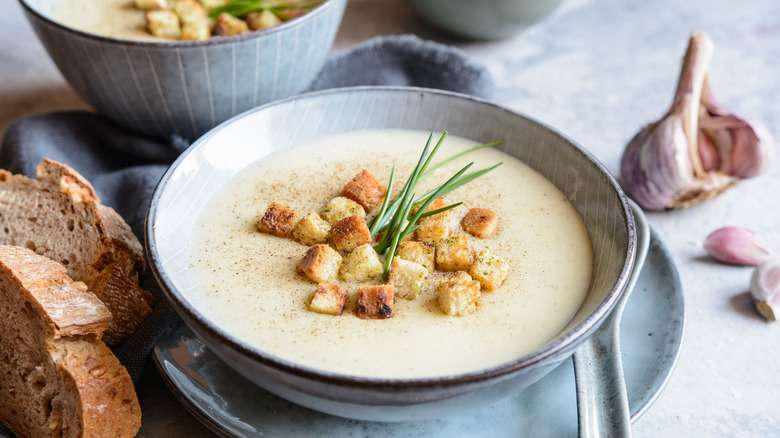The Trick To Substituting Nut Milk For Dairy In Your Go-To Soup Recipes
Soup is the perfect lunch or dinner, particularly during cool weather. It's easy to make a semblance of a meal with only a few ingredients, and it's not altogether imperative they're fresh either. It's possible to build flavor with frozen, canned, or dried items straight from the pantry. Plenty of soups feature beans, dehydrated mushrooms, grains, and jarred vegetables or seafood; you can generally get by without a trip to the market. But what if you're aiming to make a dairy-based recipe like clam chowder or cheesy broccoli and find you have no milk or cream in the fridge? Or perhaps you refrain because of an allergy or dietary restriction, yet you're experiencing an intense craving for carrot and parsnip bisque. Thanks to some basic techniques and kitchen ingenuity, there's no need to forfeit the enjoyment of these rich dishes.
Nut milks have become a reliable alternative to dairy products. Widely available, affordable, and frequently sold in aseptic cartons that don't require refrigeration until opened, they're a practical substitute. Plus, the American Society for Nutrition contends that most plant-based milk is lower in calories, fat, and sugar as compared to whole-fat cow milk. Unfortunately, it's also lower in creaminess. Sometimes thin, insipid, or broken, dairy-free soups can lack the unctuous appeal that is almost the point. Yet, CBC recommends some surefire ways to make them thick and appetizing, including adding pureed white beans, blending half the soup, or allowing the natural starches from rice or potatoes to bolster the consistency. But they share an even simpler method.
Add a little time
CBC recommends using almond or cashew milk as an appropriate substitution for dairy milk or cream in soup making. If the liquid is a little thin for your liking, simply simmer it for a bit longer than usual with the cover off, so it can reduce slightly. This old trick is employed for concentrating flavors and changing the viscosity of pan sauces and works here too. Per More Than Gourmet, this is best done slowly and with consistent heat; don't crank the burner to reach a boil or you could end up with an over-reduced or split (aka curdled) sauce.
Milk Pick explains that non-dairy milk is especially prone to splitting in environments of high heat and high acidity where the proteins separate more quickly, creating the curdling we all know and loathe. To avoid it, they suggest maintaining a low simmer, adding the milk a portion at a time, or heating it before incorporating it into the rest of the liquid. Additionally, opt for particular brands which are formulated to be more stable; Roasty Coffee lists Silk, Blue Diamond, and Pure Harvest among their top choices. By the same token, barista products developed to be combined with piping hot coffee are also suitable in soups. However, because they generally contain some added sugar, consider them only for recipes where a hint of sweetness won't be amiss, such as a pumpkin or tomato-cream bisque.
All said, we agree that time is an optimal soup thickener — next-day leftovers are always perfection.

